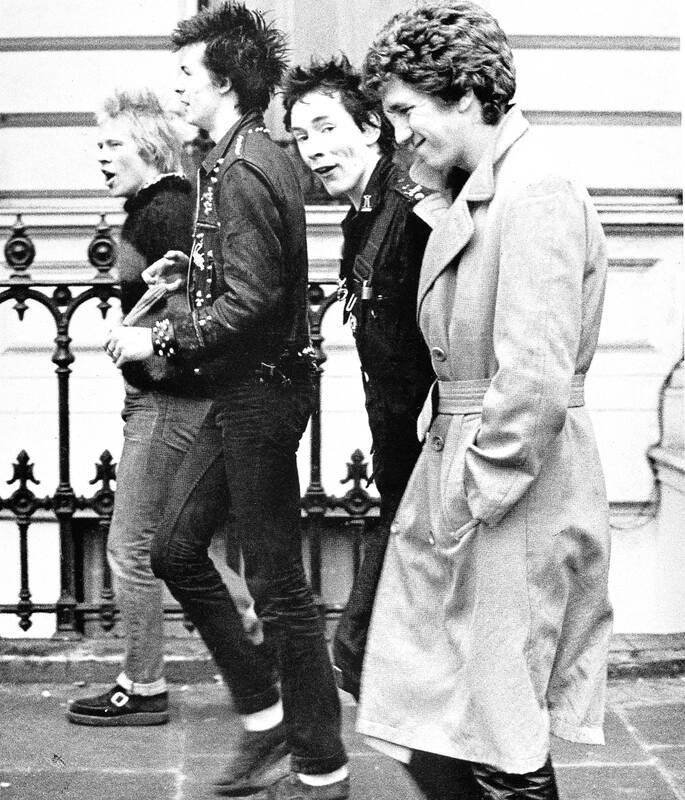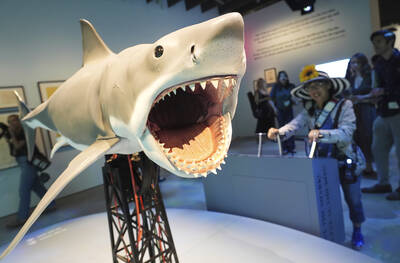From a Sex Pistols single to The Simpsons, The Crown and Andy Warhol works, Queen Elizabeth’s pop culture cameos were frequent and often unforgettable. Some depictions were affectionate, others more hostile, but the monarch’s indelible image in art, music and film cemented her status as one of the most recognizable people in the world. Here are some of her most memorable appearances.
‘GOD SAVE THE QUEEN’
With her eyes and mouth covered with collaged words, the cover of the 1977 Sex Pistols single God Save The Queen is one of the most iconic images of the punk movement — and of Elizabeth II.

Photo: AP
The artist, Jamie Reid, also created a version depicting the queen with a safety pin through her mouth and Nazi swastika symbols on her eyes.
Of the many other songs about the queen, the gentle Her Majesty by The Beatles in 1969 contrasts with Elizabeth My Dear on the 1989 debut album by The Stone Roses, where they declared they would not rest until she lost the throne.
The Queen Is Dead, the title track from the 1986 hit album by The Smiths, featured lead singer Morrissey railing against media fascination with the royal family.

Photo: AP
“The very idea of the monarchy and the queen of England is being reinforced and made to seem more useful than it really is,” Morrissey told NME magazine.
“The whole thing seems like a joke. A hideous joke.”
In 2005, electronic dance act Basement Jaxx imagined the queen on a night out in London for the music video for You Don’t Know Me, showing her visiting a strip club and getting into a fight.
WARHOL’S SILKSCREENS
The queen sat for numerous artists during her reign, including Cecil Beaton, Lucian Freud and Annie Leibovitz, showing her in full regalia, at work or with her family.
But few captured the public imagination like Andy Warhol’s silkscreens, as part of a 1985 series about reigning queens.
Warhol used an official photograph that he customized in a range of colors and styles — a treatment also used to depict stars such as Marilyn Monroe.
SCREEN TIME
Readily identified by her cut-glass accent and boldly-colored outfits, the queen was much depicted in cartoons, television shows and films.
She popped up several times in cult US series The Simpsons, including in one episode where the main character, Homer, drove into her golden carriage on the grounds of Buckingham Palace.
The monarch featured in British satirical puppet show Spitting Image and in children’s television hit Peppa Pig, where she jumped in muddy puddles.
She also featured in the movies Minions, Austin Powers in Goldmember and The Naked Gun among many others — in some of them played Jeannette Charles, her most famous British lookalike.
PRIVATE LIFE
The queen rarely gave interviews and never retailed details about her most private moments.
But cinematic portrayals of the life she was presumed to lead behind the palace gates were many.
Laid out in films, plays and television programs, all helped to shape public perceptions of the royal family.
She was depicted as a child in the Oscar-winning movie The King’s Speech, about her father King George VI’s struggle to overcome his stammer, and as a monarch, facing public anger after the 1997 death of her daughter-in-law Princess Diana, in The Queen.
One of the most influential was Netflix’s big-budget TV series The Crown, which told in luxurious detail the story of the queen and her husband Philip from before she ascended to the throne, complete with family rows, scandals and political crises.
OLYMPIC SPOOF
After years of her image being used and abused, the queen took to the screen herself in 2012 in a sketch for the opening ceremony of the London Olympic Games.
She was filmed surrounded by her beloved corgis at Buckingham Palace as she met James Bond star Daniel Craig, who was dressed as the suave spy in black tie.
“Good evening, Mr Bond,” she said, before the pair appeared to get in a helicopter, fly across London and then parachute into the stadium.
In 2016, she also appeared in a video with her grandson Prince Harry which also featured former US president Barack Obama, to promote the prince’s veterans sports championship, the Invictus Games.
One of her last appearances was with the popular animated children’s television character, Paddington Bear, at her Platinum Jubilee celebrations in June.
The pair shared a love of marmalade sandwiches and tapped out the beat to Queen’s anthem We Will Rock You to kickstart a star-studded pop concert.

The depressing numbers continue to pile up, like casualty lists after a lost battle. This week, after the government announced the 19th straight month of population decline, the Ministry of the Interior said that Taiwan is expected to lose 6.67 million workers in two waves of retirement over the next 15 years. According to the Ministry of Labor (MOL), Taiwan has a workforce of 11.6 million (as of July). The over-15 population was 20.244 million last year. EARLY RETIREMENT Early retirement is going to make these waves a tsunami. According to the Directorate General of Budget Accounting and Statistics (DGBAS), the

Many will be surprised to discover that the electoral voting numbers in recent elections do not entirely line up with what the actual voting results show. Swing voters decide elections, but in recent elections, the results offer a different and surprisingly consistent message. And there is one overarching theme: a very democratic preference for balance. SOME CAVEATS Putting a number on the number of swing voters is surprisingly slippery. Because swing voters favor different parties depending on the type of election, it is hard to separate die-hard voters leaning towards one party or the other. Complicating matters is that some voters are

Five years ago, on the verge of the first COVID lockdown, I wrote an article asking what seemed to be an extremely niche question: why do some people invert their controls when playing 3D games? A majority of players push down on the controller to make their onscreen character look down, and up to make them look up. But there is a sizable minority who do the opposite, controlling their avatars like a pilot controls a plane, pulling back to go up. For most modern games, this requires going into the settings and reconfiguring the default controls. Why do they

Take one very large shark, a boat (we’re gonna need a bigger one of those) and a movie that ran way over budget and you’ve got all the ingredients of a career-making film for one of Hollywood’s most successful directors. Now fans of Jaws — Steven Spielberg’s terrifying thriller about a man-eating shark — can re-live the movie as it celebrates its 50th anniversary in an exhibition at the Academy Museum in Los Angeles. “The film certainly cost me a pound of flesh, but gave me a ton of career,” Spielberg told reporters as he toured exhibits of props and memorabilia